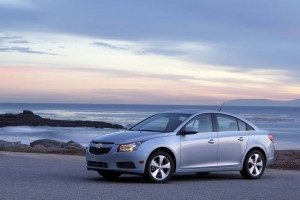
Chevy cuts by half the price of navi on the Cruze. Will it set off a price war among makers and boost demand?
If you’ve ever gotten lost trying to find a friend’s new house or a well-reviewed new restaurant you’ll undoubtedly have wished for an onboard navigation system. Portable “navis,” in fact, have become one of the hottest perennial holiday gifts.
Yet despite frequent surveys showing that a majority of motorists would like to get a car equipped with a built-in system, the technology is still only ordered on about one in ten new cars. Why the big gap? Cost, industry analysts agree. Though the price of portable navigation systems have plunged in recent years, built-in systems remain one of the most expensive options you can add to a new vehicle.
But that is starting to change, and makers like Chevrolet, which is slashing the price of navi on its 2012 Cruze, “will win” lots of new buyers “with a low-cost solution,” predicts George Peterson, head of the consulting firm AutoPacific, Inc.
“Manufacturers have their heads in the sand trying to protect the revenue model they’ve developed over the last decade,” said Peterson. But high costs don’t really generate big profits, he contends, because it results in much lower sales volumes for onboard navi technology.
Apparently, some manufacturers are starting to come up with the same conclusion. The latest is Chevrolet. The built-in navigation system on the 2012 Cruze will be offered at $995, a full $1,000 less than what Chevy charged on the 2011 model. And that’s despite the maker’s migrating to a full 7-inch display with a higher-resolution LCD screen. That makes navi an option costing the same amount as a 6-speed automatic transmission on the 2012 Chevrolet Cruze.
The new model will lose a couple of features, notably the hard-drive that allows a user to record and even pause live radio, but by adopting an SD card-based memory, a motorist could more easily record music – or update the systems maps – at home.
Chevrolet isn’t alone. Toyota is offering motorists two different navigation systems on its new Prius v, a larger version of the familiar Prius hybrid. The 2011 gas-electric wagon will feature a base system with a 6-inch navigation screen or an upgraded system with a higher-resolution, 7-inch LCD monitor.
Unfortunately, the top-line system still goes for $2,380, but that includes an extensive array of additional hardware, including a backup camera, a high-line, multimedia audio system, Bluetooth and even roadside assistance and a stolen vehicle recovery system.
Ford took a different approach when it launched the new Explorer for 2011. The crossover-utility vehicle allows a buyer to opt for a range of features, some of which already rely on a touch-screen LCD display. If the motorist then wants to add navi, as well, the price tag is another $795.
But Ford’s strategy raises as many questions as it answers. Ticking the “navi” box on the option list simply gets a buyer an SD card which plugs additional software into the system already built into the Explorer. Why, critics contend, should that cost another $795 when you can buy a reasonably functional aftermarket navigation system for just over $100, and even some of the more advanced dashboard-mounted devices for under $500?
Makers insist that this isn’t a true apples-to-apples comparison. They note that built-in navi systems usually have larger screens and offer more extensive features. Paired with the Ford MyTouch and Sync systems the Explorer lets a motorist check sports scores, look for cheap gas stations and link to some of the apps on a smartphone, such as the Pandora audio service. Factory systems also use the vehicle’s speakers, which makes directions easier to hear. And, makers contend, they’ve ruggedized their hardware to stand up to the harsh environment a car faces for the lifetime of a vehicle.
Still, analyst Peterson asks, does that really justify the added cost? Many customers are saying no, so even on expensive products like Mercedes-Benz and BMW, manufacturers have watched as buyers opt for portable systems from the likes of Tom-Tom and Garmin.
One thing is clear: motorists want navis, whether built-in, portable, or in the form of smartphone apps – the fastest-growing niche, according to industry data.
AutoPacific’s most recent survey shows 36% of buyers viewing a built-in system as Very or Extremely Important. That rises to 52% when you include those who described the technology as Somewhat Important.
As recently as 2007, only 25% of motorists saw factory nav as Very or Extremely Important.
But Peterson and other analysts warn that if automakers don’t start driving prices down they may find that a sizable share of potential customers simply opt for aftermarket systems – or migrate to manufacturers who see the light and drop prices to a more reasonable level.
